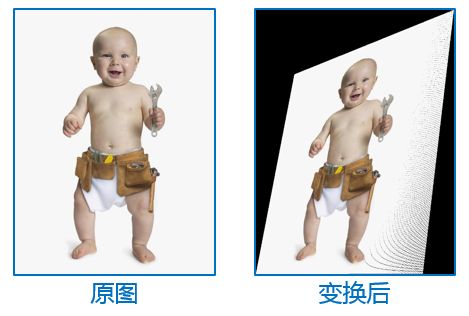【OpenCV】透视变换 Perspective Transformation(续)
透视变换的原理和矩阵求解请参见前一篇《透视变换 Perspective Transformation》。在OpenCV中也实现了透视变换的公式求解和变换函数。
求解变换公式的函数:
Mat getPerspectiveTransform(const Point2f src[], const Point2f dst[])void perspectiveTransform(InputArray src, OutputArray dst, InputArray m)int main( )
{
Mat img=imread("boy.png");
int img_height = img.rows;
int img_width = img.cols;
vector corners(4);
corners[0] = Point2f(0,0);
corners[1] = Point2f(img_width-1,0);
corners[2] = Point2f(0,img_height-1);
corners[3] = Point2f(img_width-1,img_height-1);
vector corners_trans(4);
corners_trans[0] = Point2f(150,250);
corners_trans[1] = Point2f(771,0);
corners_trans[2] = Point2f(0,img_height-1);
corners_trans[3] = Point2f(650,img_height-1);
Mat transform = getPerspectiveTransform(corners,corners_trans);
cout< ponits, points_trans;
for(int i=0;i(i);
for(int j=0;j(y);
t[x*3] = p[j*3];
t[x*3+1] = p[j*3+1];
t[x*3+2] = p[j*3+2];
count++;
}
}
imwrite("boy_trans.png",img_trans);
return 0;
} 得到变换之后的图片:
注意这种将原图变换到对应图像上的方式会有一些没有被填充的点,也就是右图中黑色的小点。解决这种问题一是用差值的方式,再一种比较简单就是不用原图的点变换后对应找新图的坐标,而是直接在新图上找反向变换原图的点。说起来有点绕口,具体见前一篇《透视变换 Perspective Transformation》的代码应该就能懂啦。
除了getPerspectiveTransform()函数,OpenCV还提供了findHomography()的函数,不是用点来找,而是直接用透视平面来找变换公式。这个函数在特征匹配的经典例子中有用到,也非常直观:
int main( int argc, char** argv )
{
Mat img_object = imread( argv[1], IMREAD_GRAYSCALE );
Mat img_scene = imread( argv[2], IMREAD_GRAYSCALE );
if( !img_object.data || !img_scene.data )
{ std::cout<< " --(!) Error reading images " << std::endl; return -1; }
//-- Step 1: Detect the keypoints using SURF Detector
int minHessian = 400;
SurfFeatureDetector detector( minHessian );
std::vector keypoints_object, keypoints_scene;
detector.detect( img_object, keypoints_object );
detector.detect( img_scene, keypoints_scene );
//-- Step 2: Calculate descriptors (feature vectors)
SurfDescriptorExtractor extractor;
Mat descriptors_object, descriptors_scene;
extractor.compute( img_object, keypoints_object, descriptors_object );
extractor.compute( img_scene, keypoints_scene, descriptors_scene );
//-- Step 3: Matching descriptor vectors using FLANN matcher
FlannBasedMatcher matcher;
std::vector< DMatch > matches;
matcher.match( descriptors_object, descriptors_scene, matches );
double max_dist = 0; double min_dist = 100;
//-- Quick calculation of max and min distances between keypoints
for( int i = 0; i < descriptors_object.rows; i++ )
{ double dist = matches[i].distance;
if( dist < min_dist ) min_dist = dist;
if( dist > max_dist ) max_dist = dist;
}
printf("-- Max dist : %f \n", max_dist );
printf("-- Min dist : %f \n", min_dist );
//-- Draw only "good" matches (i.e. whose distance is less than 3*min_dist )
std::vector< DMatch > good_matches;
for( int i = 0; i < descriptors_object.rows; i++ )
{ if( matches[i].distance < 3*min_dist )
{ good_matches.push_back( matches[i]); }
}
Mat img_matches;
drawMatches( img_object, keypoints_object, img_scene, keypoints_scene,
good_matches, img_matches, Scalar::all(-1), Scalar::all(-1),
vector(), DrawMatchesFlags::NOT_DRAW_SINGLE_POINTS );
//-- Localize the object from img_1 in img_2
std::vector obj;
std::vector scene;
for( size_t i = 0; i < good_matches.size(); i++ )
{
//-- Get the keypoints from the good matches
obj.push_back( keypoints_object[ good_matches[i].queryIdx ].pt );
scene.push_back( keypoints_scene[ good_matches[i].trainIdx ].pt );
}
Mat H = findHomography( obj, scene, RANSAC );
//-- Get the corners from the image_1 ( the object to be "detected" )
std::vector obj_corners(4);
obj_corners[0] = Point(0,0); obj_corners[1] = Point( img_object.cols, 0 );
obj_corners[2] = Point( img_object.cols, img_object.rows ); obj_corners[3] = Point( 0, img_object.rows );
std::vector scene_corners(4);
perspectiveTransform( obj_corners, scene_corners, H);
//-- Draw lines between the corners (the mapped object in the scene - image_2 )
Point2f offset( (float)img_object.cols, 0);
line( img_matches, scene_corners[0] + offset, scene_corners[1] + offset, Scalar(0, 255, 0), 4 );
line( img_matches, scene_corners[1] + offset, scene_corners[2] + offset, Scalar( 0, 255, 0), 4 );
line( img_matches, scene_corners[2] + offset, scene_corners[3] + offset, Scalar( 0, 255, 0), 4 );
line( img_matches, scene_corners[3] + offset, scene_corners[0] + offset, Scalar( 0, 255, 0), 4 );
//-- Show detected matches
imshow( "Good Matches & Object detection", img_matches );
waitKey(0);
return 0;
} 代码运行效果:
findHomography()函数直接通过两个平面上相匹配的特征点求出变换公式,之后代码又对原图的四个边缘点进行变换,在右图上画出对应的矩形。这个图也很好地解释了所谓透视变换的“Viewing Plane”。

